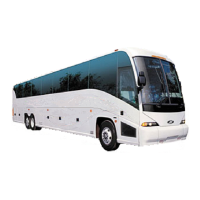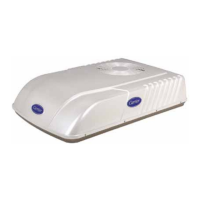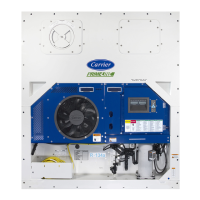2-5
T -312
2.3.2 Bypass Heat Valve Control
The normally open Bypass Heat Valve is closed on
system start--up. During re--heat, the bypass heat valve
remains closed when the heat valves are open, and
opens 2 seconds before the heat valves close (to
prevent water hammering).
2.3.3 Auxiliary Heater Control
The auxiliary heater output is energized when the heat
valve has been opened 100% for 60 seconds. Once
energized, the auxiliary heater output is de--energized
when the heat valve percentage is less than 20 percent
for fifteen minutes.
The OEM supplied Auxiliary Heater Switch located on
the left side console can independently energize the
auxiliary heater when the engine is off. When placing
the switch in the ON position, the switch activates the
auxiliary heater for a timed period of 90 minutes.
Placing the switch in the OFF position or starting the
coach engine will de--activate the auxiliary heater .
2.3.4 Humidity Control
Humidity control (reheat mode) is activated when the
humidity is greater than fifty percent and the passenger
zone temperature is less than 5_F(3_C) above set
point. When these conditions are met the compressor
will be fully loaded (6 cylinders)and at the same time the
heat valve(s) will cycle open to maintain temperature.
Once humidity control is activated, it will remain
activated until the humidity is less than 45 percent or the
return air temperature drops 2_F(1_C) below set point.
2.3.5 Compressor Unloader Control
The unloader outputs control the capacity of the
compressor by energizing or de-energizing unloader
solenoid valves. Energizing a valve solenoid
de-activates a pair of compressor cylinders. The 05G
compressor has six cylinders. Four cylinders are
equipped with two sets of unloader valves (UV1 and
UV2), each controlling two cylinders; this allows the
compressor to be operated with two, four or six
cylinders. When the compressor is off, the unloader
solenoids are de-energized immediately.
Whenever the compressor is changed from off to on, the
unloaders are forced energized for fifteen seconds.
After fifteen seconds, one unloader solenoid may be
de-energized, if required. Any subsequent changes
between energizing and de-energizing the unloader
solenoids must be staged with a thirty second delay.
Only one unloader may change state at a time when
staging is required.
a. Suction Pressure
In addition to temperature control, the electric unloaders
will be used to prevent coil frosting. Staging is ignored
for energizing the unloader solenoid due to suction
pressure overrides :
1. Compressor Unloader Bank 1 Solenoid (UV1).
When the suction pressure decreases below 25 psig
(1.7 BAR), the first unloader solenoid is energized
unloading the first compressor cylinder bank (two
cylinders); this output will remain energized until the
pressure increases to above 32 psig (2.18 BAR).
2. Compressor Unloader Bank 2 Solenoid (UV2).
When the suction pressure decreases below 21 psig
(1.43 BAR), the second unloader solenoid is ener-
gized unloading the second compressor cylinder
bank (two cylinders); this output will remain ener-
gized until the pressure increases to above 28 psig
(1.91 BAR).
b. Discharge Pressure
Head Pressure is also controlled by the unloaders.
Staging is ignored for energizing the unloader solenoid
due to discharge pressure overrides :
1. Compressor Unloader Bank 1 Solenoid (UV1).
When the discharge pressure increases above 340
psig (23.13 BAR), the first compressor unloader so-
lenoid is energized; this output will remain energized
until the pressure decreases below 300 psig (20.41
BAR).
2.3.6 Passenger Area Evaporator Fan Speed
Selection
The passenger area evaporator assembly is equipped
with a two speed fan motor . Temperature control is the
primary method of determining the fan speed selection.
Table 2-1 indicates relay operational status for the
various fan motor states.
Table 2-1. Main Evaporator Fan Speed Relay
Operation
STATE
HIGH SPEED
RELAY
LOW SPEED
RELAY
Off Off Off
Low On On
High On Off
Pull
Up/Down
On Off
2.3.7 Driver’ s Area Evaporator Fan Speed
Selection
The driver air conditioning unit is equipped with two
evaporator fan motors. The Defrost slide switch
determines the fan speed. See (Figure 2-1).
2.3.8 Condenser Fan Speed Control
The first condenser fan motor (CM1) is energized when
the compressor clutch output is energized.
The second condenser fan motor (CM2) is energized
when the clutch is energized and the discharge
pressure increases above 175 psig (1.2 mkPa). It will be
de-energized when the clutch is de-energized or the
discharge pressure decreases below 125 psig (0.861
mPa).
The condenser fans are started in low speed and will
remain in low speed until the discharge pressure
increases above 225 psig (1.6 mPa). The fans will
remain in high speed until the discharge pressure
decreases below 165 psig (1.1 mPa).

